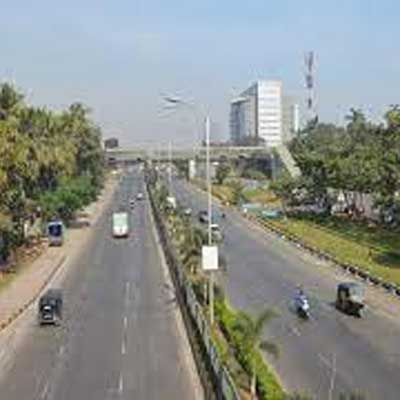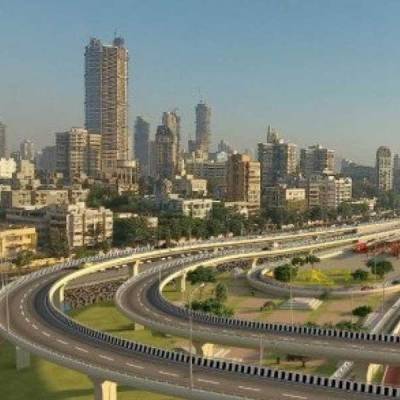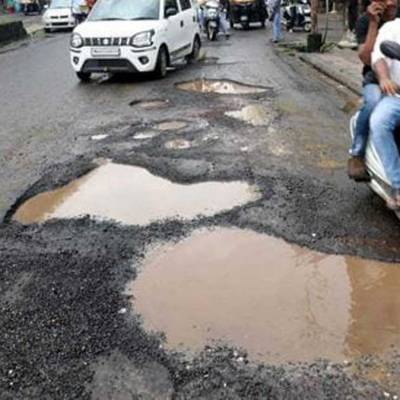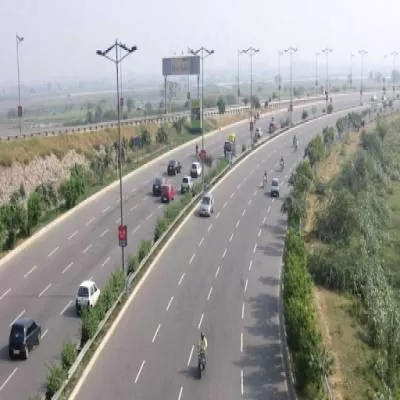- Home
- Infrastructure Transport
- ROADS & HIGHWAYS
- Shifting Trends in Road Construction

Shifting Trends in Road Construction
Transport Minister Nitin Gadkari started 2015 on an ambitious note, when he stated that all new central road projects would use concrete.
Shifting the focus on rigid pavements, shows the long-term perspective of the government, avers Sanjay Londhe, Director, Ashoka Buildcon.
Concrete: A panacea for road ills?
All the proposed central projects are national highways. Views differ on whether concrete roads make as much sense for towns and cities.
¨Concrete pavements are advisable for internal city roads and district roads,¨ opines Amit Gossain, Executive Vice President-Sales, Marketing and Business Development, JCB India. ¨Bitumen roads work better for highways and runways because their paving cost and lifecycle cost is much lower.¨
¨It makes sense to have city roads made of concrete,¨ notes Londhe. ¨In case of flexible pavements, closing lanes for repairs causes havoc in cities.¨
Rigid (concrete) pavements are superior to flexible (bitumen) pavements in many respects.
¨Rigid pavements require much less maintenance,¨ elaborates Londhe. ¨They have a longer life and offer more user comfort. Rigid pavements sustain climatic extremes much better such as sudden downpours causing flash floods. Rigid pavements are eco-friendly as the aggregate isn´t heated in the road laying process. Well-made rigid pavements form no potholes and sustain no damage. The Mumbai-Pune Expressway is a good example.¨
¨Cement concrete roads are the solution to the ever-increasing traffic and to meet demand for long-term performance of pavements with little maintenance,¨ says G Kavitha, Assistant Professor, Resource Centre for Asphalt and Training Academy. ¨Although the initial cost of construction of cement concrete roads is marginally higher than bituminous roads, their lifecycle cost is less than bituminous pavements.¨
Concreting precision
Concrete pavements entail a 10 to 30 per cent higher capital cost than flexible pavements, considering the overall cost in equipment and materials, according to Londhe.
¨Concrete roads mandate the use of a slip-form paver instead of an asphalt paver, a concrete batching plant in place of an asphalt plant and eliminate the use of double-drum tandem rollers,¨ says Gossain. ¨While a concrete slip paver mandates a much higher investment than an asphalt paver, a concrete batching plant is less expensive than an asphalt plant.¨
¨Typically, if a project of around 20 km has been awarded, a concrete production plant close to the site is a must-have, with the plant´s capacity depending on the (length of the) stretch of road,¨ says Ramesh Palagiri, Managing Director & CEO, Wirtgen India.
Londhe also points out that constructing concrete pavements mandates far more precision, planning and supervision than asphalt roads. ¨Improper compaction or the incorrect use of the concrete paver or improper curing can cause road failures,¨ he says. ¨Getting the specifications right and having a well-trained team is more critical in concrete roads than in flexible pavements.¨
For instance, irrespective of the length of the rigid pavement under construction, a concrete batching plant with minimum capacity of 120 cu m per hour is needed to keep the paver moving at the designated constant speed of 0.8 m to 1 m per minute to ensure a better quality concrete road.
¨During construction, concrete roads also face limitations of weather, temperature and other aspects compared to flexible pavements,¨ adds Londhe.
Plugging the skill gap
Building all new highways of concrete could present additional challenges. ¨Mandating that all new national highways be made of concrete would impose constraints on the availability of resources,¨ says Londhe. ¨Also, finding sufficient experts for the quality supervision of many projects being executed simultaneously would be challenging.¨
Organisations like the Resource Centre for Asphalt and Training Academy (RASTA) may help plug this skill gap.
RASTA conducts training programmes on various aspects of road building such as latest technologies, use of improved materials and techniques, quality control and quality assurance, building green roads, design and construction of bituminous pavements, cement concrete pavements and composite pavements. It has trained 3,500 people from government organisations, such as the National Rural Roads Development Agency, Karnataka Rural Road Development Agency, Karnataka Public Works Department, and private companies such as GMR, ITDC and Brigade Group. ¨Participants can be trained at various levels of competency,¨ says KS Aithal, Administrator, RASTA. ¨Past participants have included key decision makers as well as engineers responsible for project execution.¨
¨With the focus on concrete pavements, training may be mandated on aspects such as the placement of joints and their importance, types of reinforcements and their importance, joints maintenance, ways to reduce carbon footprint during construction, technologies for the long-term performance of pavements, and performance of technologies like cell-filled concrete, interlocked concrete block pavements and roller compacted concrete,¨ adds Kavitha.
RASTA can also help diagnose and identify solutions for premature pavement failures, pavement distress, etc. It can be involved as a quality monitoring consultant as Karnataka Industrial Areas Development Board (KIADB) has done for projects across Karnataka, and to design and prepare detailed project reports (DPR) for concrete roads.
Spotlight on recycling
As the road construction industry matures, recycling is also expected to be promoted.
¨Road recycling confers excellent results,¨ says Londhe. ¨I´ve seen recycled roads last at least two monsoon seasons without mandating any repairs. Recycling should be made mandatory. It is a criminal waste of good material that gets buried under the overlays. We have saved 30 per cent material in adopting ecycling using Speco, Marini and Linnhoff hot mix plants.¨
¨Recycling can save about 70 per cent of aggregate and bitumen mix vis-a-vis the existing method of overlaying,¨ opines G Boopathi, Manager Civil, Technology Competency Centre, Heavy Civil Infrastructure IC, Larsen & Toubro Ltd. ¨It is cost-effective overall and environment-friendly. It also maintains the height of the road, and consequently preserves alteration of other elements like the pedestrian footpath, central median (road separator), traffic signals posts and streetlights.¨
Municipalities and authorities are still to take up recycling and other new technologies in a big way.
¨Mumbai has introduced advanced technologies for pothole repair, including carbon core technology, a quick-fix solution applied without heating the bitumen,¨ says Gossain.
But it is Chennai Corporation that provides a great example of how to maintain city roads, according to Palagiri. ¨It is one of very few corporations in India where milling is extensively used to maintain levels of roads and for a good finish after repairs,¨ he says. Close to 25 Wirtgen milling machines are deployed for the purpose.
Increased emphasis on road recycling will grow demand for milling equipment. With traffic on ageing roads increasing, Hiten Kapadia, Business Line Manager-Road Construction Equipment, Dynapac, Atlas Copco, sees compact planers for cold milling applications as an important segment. ¨Planers will play a vital role in the upkeep of the roads and help reclaim material for reuse,¨ he says. ¨We expect demand for milling machines to grow in the near future as more state authorities approve and mandate the use of recycled asphalt (RAP) and with the scarcity of aggregate accentuating in some areas.¨
Atlas Copco offers compact planers. Dynapac PL350, PL500 and PL1000 compact cold planers have milling widths from 0.35 m to 1 m and can achieve a depth of 200 mm to 300 mm vis-a-vis a normal depth of 80 mm in generalised conditions. Their small cutting radius of only 230 mm makes the high-performance Dynapac PL1000 compact planers flexible for milling, even around manholes and so on. They are available as four-wheeled units.
Now, it´s time for the ´recycle´ mantra to become a concrete mindset.
- Concrete pavements advisable for internal city and district roads.
- Rigid pavements require much less maintenance, have longer life.
- Cement concrete roads to meet demand for long-term performance of pavements with little maintenance.
- Road recycling confers excellent results, is cost-effective and environment-friendly.
Select the correct road recycling equipment
¨Efficiency of road recycling mainly depends on the quality of cutters used for scrapping, the manoeuvrability quotient of the equipment in curves, the skill level of the operator and service support to minimise downtime,¨ says G Boopathi, Manager Civil, Technology Competency Centre, Heavy Civil Infrastructure IC, Larsen & Toubro Ltd. ¨Visibility of the road for the operator is also a must-have feature.¨ It is also advisable to follow best buying practices, such as ensuring operator training and spares and support are readily available, and that the equipment has good references.
Tips for smooth steel bridge construction
¨Steel bridges are popular because of their high quality, speedy construction, versatility, ease in modification and repair, durability and good aesthetics,¨ says G Boopathi, Manager Civil, Technology Competency Centre, Heavy Civil Infrastructure IC, Larsen & Toubro Ltd. To ensure smooth steel bridge construction, he suggests adhering to the following work sequence:
- Check the availability of sections in the market before releasing the drawings for construction (action by designer).
- Ensure the site team fully comprehends the erection sequence and methodology.
- Prepare shop drawings for details of the connections and fabrication of various elements.
- Exercise quality checks at each stage.
- Work out a traffic diversion plan before erection.
- Ensure a safe work environment at all stages of construction.
- Select a crane of adequate capacity for lifting the steel sections.
Market watch: Demand for road construction equipment
¨Demand for road equipment has not been encouraging so far in this fiscal,¨ says Dimitrov Krishnan, Vice President, Volvo Construction Equipment India.
¨It remains at the same level as last year - about 400 pavers and 2,500+ compaction equipments of various tonnage and class. But we are expecting considerable growth in demand as a result of the initiatives of the Centre and state governments to resolve common problems like land acquisition and utility clearances.¨ ¨Overall demand for road construction equipment is growing marginally,¨ says Hiten Kapadia, Business Line Manager-Road Construction Equipment, Dynapac, Atlas Copco. ¨With concrete highways, demand for asphalt paver finishers may get slightly affected. However, in the next five years, we believe there will be a realisation of the huge untapped potential in all product segments of the CE industry, especially road construction equipment. Besides compactors, pavers and tandem rollers, equipment such as planers (cold milling machines), material feeders, etc, will also get an opportunity to deliver higher quality roads in India. Recent surveys indicate that in developing markets like India, road infrastructure will be an extremely important component to support growth opportunities. We expect demand to peak only in 2017.¨
Compactors: 2,500 to 2,800
Asphalt pavers (bigger highway class pavers): 100
Asphalt pavers (smaller city class pavers): 250
Motor graders: 400 units
Building bridges: All concrete or composite?
¨Bridges can be built of concrete girders and slab or of steel girders and slab (composite),¨ says Sanjay Londhe, Director, Ashoka Buildcon. ¨Composite bridges are about 40 per cent more expensive but deliver better outcomes provided the steel girders are manufactured in a workshop under stringent quality control. On-site welding and cutting can never yield the best quality. Composite bridges weigh less and can be of lower height and can be completed faster. Hence, false cost is reduced. The excess cost of composite construction can be justified as such structures are major timesavers.¨
Ashoka Buildcon has successfully demonstrated how a composite bridge can be speedily constructed. ¨We completed 323 m of a half-finished bridge over the Roopnarayan river in West Bengal by launching a steel girder assembly of 323 m span. We also constructed a parallel new bridge of 1,100 m. Building the bridges was part of a BOT project, the six-laning of the Dhankuni-Kharagpur section of NH-6 from 17.600 km to 129.000 km. It marked the first time in India that segmental construction was used for bridges. We completed the bridge 18 months ahead of schedule,¨ adds Londhe.
- Concrete Roads
- Road Recycling
- Transport Minister
- Nitin Gadkari
- Sanjay Londhe
- Ashoka Buildcon
- New Central Road Projects
- Amit Gossain
- JCB India
- G Kavitha
- Resource Centre Asphalt and Training Academy
- RASTA
- Ramesh Palagiri
- Wirtgen India
- GMR
- ITDC
- Brigade Group
- KS Aithal
- Karnataka Industrial Areas Development Board
- KIADB
- Speco
- Marini
- Linnhoff Hot Mix Plants
- G Boopathi
- Larsen & To
With the focus shifting to concrete roads and road recycling, how should construction companies gear up? Transport Minister Nitin Gadkari started 2015 on an ambitious note, when he stated that all new central road projects would use concrete. Shifting the focus on rigid pavements, shows the long-term perspective of the government, avers Sanjay Londhe, Director, Ashoka Buildcon. Concrete: A panacea for road ills? All the proposed central projects are national highways. Views differ on whether concrete roads make as much sense for towns and cities. ¨Concrete pavements are advisable for internal city roads and district roads,¨ opines Amit Gossain, Executive Vice President-Sales, Marketing and Business Development, JCB India. ¨Bitumen roads work better for highways and runways because their paving cost and lifecycle cost is much lower.¨ ¨It makes sense to have city roads made of concrete,¨ notes Londhe. ¨In case of flexible pavements, closing lanes for repairs causes havoc in cities.¨ Rigid (concrete) pavements are superior to flexible (bitumen) pavements in many respects. ¨Rigid pavements require much less maintenance,¨ elaborates Londhe. ¨They have a longer life and offer more user comfort. Rigid pavements sustain climatic extremes much better such as sudden downpours causing flash floods. Rigid pavements are eco-friendly as the aggregate isn´t heated in the road laying process. Well-made rigid pavements form no potholes and sustain no damage. The Mumbai-Pune Expressway is a good example.¨ ¨Cement concrete roads are the solution to the ever-increasing traffic and to meet demand for long-term performance of pavements with little maintenance,¨ says G Kavitha, Assistant Professor, Resource Centre for Asphalt and Training Academy. ¨Although the initial cost of construction of cement concrete roads is marginally higher than bituminous roads, their lifecycle cost is less than bituminous pavements.¨ Concreting precision Concrete pavements entail a 10 to 30 per cent higher capital cost than flexible pavements, considering the overall cost in equipment and materials, according to Londhe. ¨Concrete roads mandate the use of a slip-form paver instead of an asphalt paver, a concrete batching plant in place of an asphalt plant and eliminate the use of double-drum tandem rollers,¨ says Gossain. ¨While a concrete slip paver mandates a much higher investment than an asphalt paver, a concrete batching plant is less expensive than an asphalt plant.¨ ¨Typically, if a project of around 20 km has been awarded, a concrete production plant close to the site is a must-have, with the plant´s capacity depending on the (length of the) stretch of road,¨ says Ramesh Palagiri, Managing Director & CEO, Wirtgen India. Londhe also points out that constructing concrete pavements mandates far more precision, planning and supervision than asphalt roads. ¨Improper compaction or the incorrect use of the concrete paver or improper curing can cause road failures,¨ he says. ¨Getting the specifications right and having a well-trained team is more critical in concrete roads than in flexible pavements.¨ For instance, irrespective of the length of the rigid pavement under construction, a concrete batching plant with minimum capacity of 120 cu m per hour is needed to keep the paver moving at the designated constant speed of 0.8 m to 1 m per minute to ensure a better quality concrete road. ¨During construction, concrete roads also face limitations of weather, temperature and other aspects compared to flexible pavements,¨ adds Londhe. Plugging the skill gap Building all new highways of concrete could present additional challenges. ¨Mandating that all new national highways be made of concrete would impose constraints on the availability of resources,¨ says Londhe. ¨Also, finding sufficient experts for the quality supervision of many projects being executed simultaneously would be challenging.¨ Organisations like the Resource Centre for Asphalt and Training Academy (RASTA) may help plug this skill gap. RASTA conducts training programmes on various aspects of road building such as latest technologies, use of improved materials and techniques, quality control and quality assurance, building green roads, design and construction of bituminous pavements, cement concrete pavements and composite pavements. It has trained 3,500 people from government organisations, such as the National Rural Roads Development Agency, Karnataka Rural Road Development Agency, Karnataka Public Works Department, and private companies such as GMR, ITDC and Brigade Group. ¨Participants can be trained at various levels of competency,¨ says KS Aithal, Administrator, RASTA. ¨Past participants have included key decision makers as well as engineers responsible for project execution.¨ ¨With the focus on concrete pavements, training may be mandated on aspects such as the placement of joints and their importance, types of reinforcements and their importance, joints maintenance, ways to reduce carbon footprint during construction, technologies for the long-term performance of pavements, and performance of technologies like cell-filled concrete, interlocked concrete block pavements and roller compacted concrete,¨ adds Kavitha. RASTA can also help diagnose and identify solutions for premature pavement failures, pavement distress, etc. It can be involved as a quality monitoring consultant as Karnataka Industrial Areas Development Board (KIADB) has done for projects across Karnataka, and to design and prepare detailed project reports (DPR) for concrete roads. Spotlight on recycling As the road construction industry matures, recycling is also expected to be promoted. ¨Road recycling confers excellent results,¨ says Londhe. ¨I´ve seen recycled roads last at least two monsoon seasons without mandating any repairs. Recycling should be made mandatory. It is a criminal waste of good material that gets buried under the overlays. We have saved 30 per cent material in adopting ecycling using Speco, Marini and Linnhoff hot mix plants.¨ ¨Recycling can save about 70 per cent of aggregate and bitumen mix vis-a-vis the existing method of overlaying,¨ opines G Boopathi, Manager Civil, Technology Competency Centre, Heavy Civil Infrastructure IC, Larsen & Toubro Ltd. ¨It is cost-effective overall and environment-friendly. It also maintains the height of the road, and consequently preserves alteration of other elements like the pedestrian footpath, central median (road separator), traffic signals posts and streetlights.¨ Municipalities and authorities are still to take up recycling and other new technologies in a big way. ¨Mumbai has introduced advanced technologies for pothole repair, including carbon core technology, a quick-fix solution applied without heating the bitumen,¨ says Gossain. But it is Chennai Corporation that provides a great example of how to maintain city roads, according to Palagiri. ¨It is one of very few corporations in India where milling is extensively used to maintain levels of roads and for a good finish after repairs,¨ he says. Close to 25 Wirtgen milling machines are deployed for the purpose. Increased emphasis on road recycling will grow demand for milling equipment. With traffic on ageing roads increasing, Hiten Kapadia, Business Line Manager-Road Construction Equipment, Dynapac, Atlas Copco, sees compact planers for cold milling applications as an important segment. ¨Planers will play a vital role in the upkeep of the roads and help reclaim material for reuse,¨ he says. ¨We expect demand for milling machines to grow in the near future as more state authorities approve and mandate the use of recycled asphalt (RAP) and with the scarcity of aggregate accentuating in some areas.¨ Atlas Copco offers compact planers. Dynapac PL350, PL500 and PL1000 compact cold planers have milling widths from 0.35 m to 1 m and can achieve a depth of 200 mm to 300 mm vis-a-vis a normal depth of 80 mm in generalised conditions. Their small cutting radius of only 230 mm makes the high-performance Dynapac PL1000 compact planers flexible for milling, even around manholes and so on. They are available as four-wheeled units. Now, it´s time for the ´recycle´ mantra to become a concrete mindset. Concrete pavements advisable for internal city and district roads. Rigid pavements require much less maintenance, have longer life. Cement concrete roads to meet demand for long-term performance of pavements with little maintenance. Road recycling confers excellent results, is cost-effective and environment-friendly. Select the correct road recycling equipment ¨Efficiency of road recycling mainly depends on the quality of cutters used for scrapping, the manoeuvrability quotient of the equipment in curves, the skill level of the operator and service support to minimise downtime,¨ says G Boopathi, Manager Civil, Technology Competency Centre, Heavy Civil Infrastructure IC, Larsen & Toubro Ltd. ¨Visibility of the road for the operator is also a must-have feature.¨ It is also advisable to follow best buying practices, such as ensuring operator training and spares and support are readily available, and that the equipment has good references. Tips for smooth steel bridge construction ¨Steel bridges are popular because of their high quality, speedy construction, versatility, ease in modification and repair, durability and good aesthetics,¨ says G Boopathi, Manager Civil, Technology Competency Centre, Heavy Civil Infrastructure IC, Larsen & Toubro Ltd. To ensure smooth steel bridge construction, he suggests adhering to the following work sequence: Check the availability of sections in the market before releasing the drawings for construction (action by designer). Ensure the site team fully comprehends the erection sequence and methodology. Prepare shop drawings for details of the connections and fabrication of various elements. Exercise quality checks at each stage. Work out a traffic diversion plan before erection. Ensure a safe work environment at all stages of construction. Select a crane of adequate capacity for lifting the steel sections. Market watch: Demand for road construction equipment ¨Demand for road equipment has not been encouraging so far in this fiscal,¨ says Dimitrov Krishnan, Vice President, Volvo Construction Equipment India. ¨It remains at the same level as last year - about 400 pavers and 2,500+ compaction equipments of various tonnage and class. But we are expecting considerable growth in demand as a result of the initiatives of the Centre and state governments to resolve common problems like land acquisition and utility clearances.¨ ¨Overall demand for road construction equipment is growing marginally,¨ says Hiten Kapadia, Business Line Manager-Road Construction Equipment, Dynapac, Atlas Copco. ¨With concrete highways, demand for asphalt paver finishers may get slightly affected. However, in the next five years, we believe there will be a realisation of the huge untapped potential in all product segments of the CE industry, especially road construction equipment. Besides compactors, pavers and tandem rollers, equipment such as planers (cold milling machines), material feeders, etc, will also get an opportunity to deliver higher quality roads in India. Recent surveys indicate that in developing markets like India, road infrastructure will be an extremely important component to support growth opportunities. We expect demand to peak only in 2017.¨ Compactors: 2,500 to 2,800 Asphalt pavers (bigger highway class pavers): 100 Asphalt pavers (smaller city class pavers): 250 Motor graders: 400 units Building bridges: All concrete or composite? ¨Bridges can be built of concrete girders and slab or of steel girders and slab (composite),¨ says Sanjay Londhe, Director, Ashoka Buildcon. ¨Composite bridges are about 40 per cent more expensive but deliver better outcomes provided the steel girders are manufactured in a workshop under stringent quality control. On-site welding and cutting can never yield the best quality. Composite bridges weigh less and can be of lower height and can be completed faster. Hence, false cost is reduced. The excess cost of composite construction can be justified as such structures are major timesavers.¨ Ashoka Buildcon has successfully demonstrated how a composite bridge can be speedily constructed. ¨We completed 323 m of a half-finished bridge over the Roopnarayan river in West Bengal by launching a steel girder assembly of 323 m span. We also constructed a parallel new bridge of 1,100 m. Building the bridges was part of a BOT project, the six-laning of the Dhankuni-Kharagpur section of NH-6 from 17.600 km to 129.000 km. It marked the first time in India that segmental construction was used for bridges. We completed the bridge 18 months ahead of schedule,¨ adds Londhe.






















